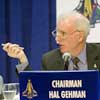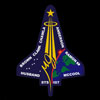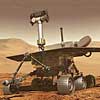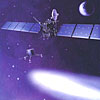|
Sunday:
May 25, 2003 | |
0343 GMT |
 |
Satellite of Milky Way found in retrograde orbit
New observations with National Science Foundation's Robert C. Byrd Green Bank Telescope suggest that what was once believed to be an intergalactic cloud of unknown distance and significance, is actually a previously unrecognized satellite galaxy of the Milky Way orbiting backward around the Galactic center.
 FULL STORY FULL STORY
 |  |

|
 |
NASA computer models may lead to quake forecasts
Advanced computer simulation tools now being developed by NASA and university researchers may soon give scientists new insights into the complex and mysterious physics of earthquakes and enable vastly improved earthquake forecasting.
 FULL STORY FULL STORY
 |  |

|
 |
|
Saturday:
May 24, 2003 | |
0001 GMT |
 |
Columbia rescue mission feasible, but unlikely
If NASA managers had realized early on that Columbia had suffered a catastrophic breach in its left wing during launch - either by obtaining satellite imagery or, more likely, by having the astronauts stage an inspection spacewalk - they might have had time to mount a repair spacewalk or even an emergency rescue mission with the shuttle Atlantis, the chairman of the Columbia Accident Investigation Board said Friday.
 FULL STORY FULL STORY
 |  |

|
 |
King named new director of Marshall Space Flight Center
NASA has announced David A. King, a former space shuttle launch director, as the new center director for the Marshall Space Flight Center, Huntsville, Ala. King is currently Marshall's deputy director.
 FULL STORY FULL STORY
 |  |

|
 |
|
Friday:
May 23, 2003 | |
0157 GMT |
 |
Martian view of Earth
Have you ever wondered what you would see if you were on Mars looking at the Earth through a small telescope? Now you can find out, thanks to a unique view of our world recently captured by NASA's Mars Global Surveyor spacecraft currently orbiting the Red Planet.
 FULL STORY FULL STORY
 |  |

|
 |
Hubble sees the mysterious 'Garden-sprinkler' nebula
There are many mysterious objects seen in the night sky which are not really well understood. For example, astronomers are puzzled by the "jets" emerging from planetary nebulae. However, the S-shaped jet from Henize 3-1475 is the most perplexing of all.
 FULL STORY FULL STORY
 |  |

|
 |
|
Thursday:
May 22, 2003 | |
0220 GMT |
 |
The Universe's biggest construction sites
Images made by NASA's Chandra X-ray Observatory have revealed two distant cosmic construction sites buzzing with activity. This discovery shows how super massive black holes control the growth of massive galaxies in the distant Universe.
 FULL STORY FULL STORY
 |  |

|
 |
Frozen light research holds promise, NASA says
NASA-funded research at Harvard University, Cambridge, Mass., that literally stops light in its tracks, may someday lead to breakneck-speed computers that shelter enormous amounts of data from hackers.
 FULL STORY FULL STORY
 |  |

|
 |
|
Wednesday:
May 21, 2003 | |
0242 GMT |
 |
Slag on shuttle debris suggests location of breach
Based on chemical analysis of slag found on the back side of a wing leading edge fragment, investigators now believe the breach that destroyed the shuttle Columbia occurred at or very near the lower inboard corner of reinforced carbon carbon panel No. 8, very close to where a so-called T-seal was mounted between RCC panels 7 and 8.
 FULL STORY FULL STORY
 |  |

|
 |
Spaceflight Now Plus: Columbia press briefing
Members of the Columbia Accident Investigation Board held their near-weekly news conference in Houston on Tuesday, updating reporters and the public on the progress of the inquiry.
 |  |

|
 |

Video coverage for subscribers only:
 VIDEO: WATCH ENTIRE 62-MINUTE NEWS CONFERENCE QT VIDEO: WATCH ENTIRE 62-MINUTE NEWS CONFERENCE QT
 SUBSCRIBE NOW SUBSCRIBE NOW

|
Newly-discovered star may be third-closest to us
The local celestial neighborhood just got more crowded with a discovery of a star that may be the third closest to the Sun. The star, "SO25300.5+165258," is a faint red dwarf star estimated to be about 7.8 light-years from Earth in the direction of the constellation Aries.
 FULL STORY FULL STORY
 |  |

|
 |
Five spacecraft join to solve an auroral puzzle
Five spacecraft have made a remarkable set of observations, leading to a breakthrough in understanding the origin of a peculiar and puzzling type of aurora. Seen as bright spots in Earth's atmosphere and called "dayside proton auroral spots," they are now known to occur when fractures appear in the Earth's magnetic field, allowing particles emitted from the Sun to pass through and collide with molecules in our atmosphere.
 FULL STORY FULL STORY
 |  |

|
 |
Marshall Space Flight Center director steps down
NASA has announced the reassignment of Art Stephenson, Center Director of the Marshall Space Flight Center in Huntsville, Ala., effective June 15. Stephenson decided to step down from his current position and move to an important role in promoting NASA's Education efforts until his retirement in January 2004.
 FULL STORY FULL STORY
 |  |

|
 |
|
Tuesday:
May 20, 2003 | |
0430 GMT |
 |
Air Force weather satellite launch rescheduled
The long-delayed launch of the U.S. military's next polar-orbiting weather satellite is being targeted for this summer, the Air Force said Monday.
 FULL STORY FULL STORY
 |  |

|
 |
Exploration extravaganza
Mission controllers at NASA's Jet Propulsion Laboratory are ramping up for an era of unprecedented space exploration. The Lab is poised to launch and direct a fleet of space probes that will, among many other things, crash into the heart of a distant comet, snatch particles of the solar wind, rove across Mars to search for evidence of liquid water, and descend through the atmosphere of Saturn's moon Titan to explore what reminds many scientists of an early Earth.
 FULL STORY FULL STORY
 |  |

|
 |
|
Monday:
May 19, 2003 | |
0503 GMT |
 |
Future of Rosetta comet explorer hinges on money
Questions concerning the future of Europe's Rosetta comet probe are slowly being answered, but perhaps the biggest question of all -- that of funding -- is still left open after a high-level meeting last week.
 FULL STORY FULL STORY
 |  |

|
 |

